What causes flat tyres on bicycles? How to prevent, or at least reduce the probability of having a flat tyre? Before we start, it is important to use a high-quality rim tape, and to properly mount the tyre and the tape.
1. Why do rear tyres get flats more often?
Nails, glass shards and other sharp objects that can puncture a tyre, usually lie on the ground flat (they aren’t very stable when the sharp part is sticking upwards).
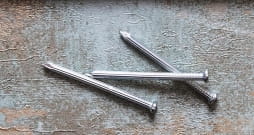
When the front wheel comes over a nail or a glass shard, they can pop up just enough (and stay that way long enough) to pierce through the rear tyre. The front wheel sort of “launches them.”
An exception to this rule is if you are riding in areas that have a lot of thorns with more than one sharp end – like Goat’s-head:
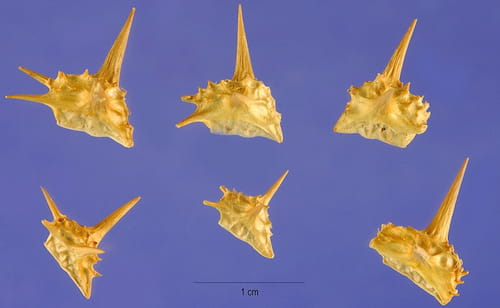
These kinds of thorns have more than one sharp edge and have a shape such that one of the thorns is likely to be pointed upwards. So you are more likely to have the front tyre punctured since it is the first one to come over such thorns. I’ve had a front tyre pick up to three of these in one go. 🙂
2. Why do you get more flats when it’s raining?
Water acts as an effective lubricant. Making it easier for sharp objects to pierce and cut rubber.
Try cutting an old tube with a dry razor. Then dip the razor in some water and try again. 🙂 A wet razor will cut a lot more easily and make deeper cuts.
Also, wet glass etc. can stick to the tyre. Even if it’s laying flat on the ground, when it sticks, it can move as the wheel rotates, getting lifted just enough to stay “hanging off the tyre” so when that spot makes contact with the ground, it gets pushed in with its sharp edge towards the tyre.
In addition to all that, water (and small ponds) can make the sharp objects be more difficult to spot and avoid – which leads us to the next chapter:
3. How to avoid getting punctures?
Paying attention
The most efficient method is to look where you are going. I know it sounds obvious, but it works wonderfully. After a while it gets instinctive – without any conscious effort I “automatically” (“instinctively”) look for any sharp debris on the ground (glass shards, sharp metal etc.) and avoid it.
For the night (and rain) it helps if you have good bicycle lights.
Pressure and tyre width
It also helps if the tyres are inflated to optimal pressure. Tyres that are underinflated are more likely to get pinch-flats (snake-bite) when hitting a rock, or a pothole. On the other hand, if the tyres are too hard (pressure too high), they will more easily be punctured, compared to tyres that have some give, that aren’t overinflated.
A few decades ago, 28 mm wide road bike tyres were considered a heresy – and many frames couldn’t even fit tyres of that width. For my weight, 23 mm wide tyres need over 7 bars of pressure, while I can pump 28 mm wide tyres to under 6 bars. In my experience, with all else being equal (road quality, tyre make and model etc.), wider tyres get fewer punctures from sharp rocks, glass shards etc, because of the lower pressure.
Addition: are narrower tyres faster?
3.1. Puncture-resistant tyres
There are tyres with hard rubber and kevlar reinforced layers that are pierced with a lot more difficulty. A good example is Schwalbe Marathon Plus model (Amazon affiliate link):
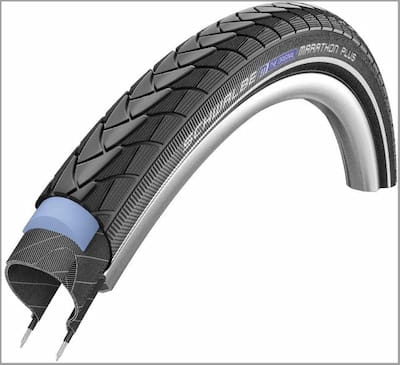
These tyres are more puncture-resistant, but you can get punctures with them as well (not puncture-proof).
The downsides of puncture-resistant tyres is they are heavier, less compliant (less comfortable) and more difficult to mount and dismount (for when you do get a flat). I prefer riding on “normal,” fast, high-quality tyres, just minding where I’m going. Even for bicycle commuting.
Still, if you are riding in areas where the above-shown Goat’s head is widely spread, puncture-resistant tyres can be a good idea.
There are also puncture protection tyre liners (Amazon affiliate link):
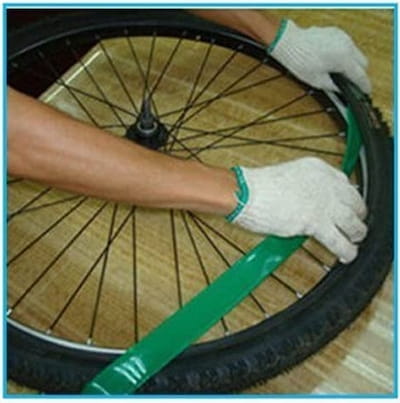
I find these liners a hassle to install and I think that puncture-resistant tyres are a better idea than using tyre-liners.
3.2. Tubeless tyres and tyre sealant
Tubeless tyres don’t use a tube, so they are resistant to pinch-flats (“snakebite flats”).
These tyres need sealant, which also helps “automatically fix” (seal) some smaller punctures – like a small thorn etc.
In case of larger cuts or some other problems, you get covered in the sealant (“slime” 🙂 ) and are likely to have a lot of fun, often requiring you to use a tube until you get to a garage/service.
I wrote here about the pros and cons of tubeless tyres.
4. Conclusion
What I do and has served me well:
Look where you are riding, and carry some tools for patching flats (and a spare tube just in case).
How to patch a flat bicycle tyre.
5. Video about avoiding flats
Last updated:
Originally published:

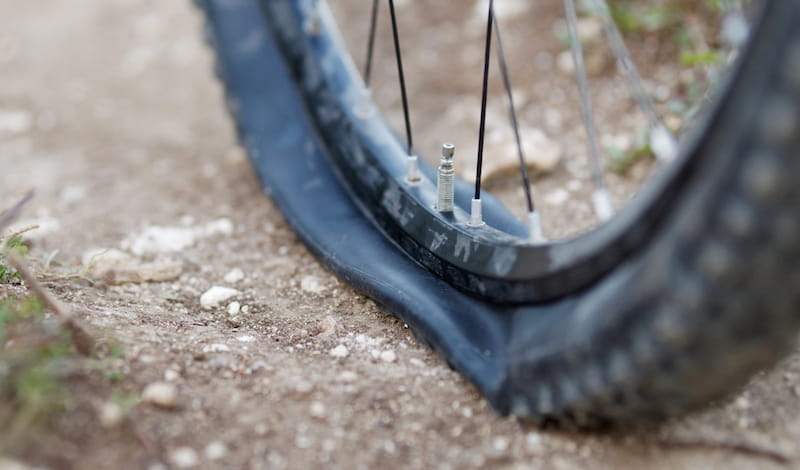
in the early days when there were no tire liners we would cut an older inner tube and wrap that around the tube,it worked very well against fine glass and thorns,yes its much easier to buy thornproof tubes or tires,i get alot less flats running smooth tires pumped up hard,most flats are caused by poorly fitted rim tape or rim tape that just does not go the distance,you will eventually get a few flats no matter what you do as that very fine glass eventually cuts your tube,most modern tires have very good puncture protection.would you believe old rim tape was nothing more than a flat piece cotton that looked like an old football shoe lace wraped around a very heavy steel single walled rim.over time the cotton rotted away and the steel rims usually rusted out as well.i like the lighter tires and they do give a nicer ride and i will put up with a flat every now and then,the less weight you put on the bike the better as if you hit a head wind and a nice hill your going to feel all that extra weight,my old steel bike has all lightweight alloy parts and its not too bad
if you are not sure about which tyres to buy for your bicycle take a look at this website https://www.bicyclerollingresistance.com this site gives a good rundown on just about all bicycle tyres,they cover puncture protection,tyre weight,how thick tyre treads are,it covers just about all you need to know about making a tyre purchase,if you also look at the readers comments section they will also tell you what tyres are durable and what tyres are high end,google user reviews are now another good place to see what tyres are worth buying,google user reviews are a very good place to have a look before you buy just about anything on the web
Thanks Mike – good resource. 🙂
I’ve also explained the tyre construction and rolling resistance in this article:
Are narrower tyres “faster” – rolling resistance
Hi Relja,i do enjoy reading all your articles and watching your youtube clips,you are providing readers with very good bicycle information and its very easy to understand.,you should be very proud of your website and the hard work that you have done,i even watched your talking monkey youtube clip,in australia when we do bussiness we call that talking turkey,i have learned alot about bikes reading your webpages,so thank you for great bicycle information,i will try not to talk too much cheers Relja and keep up the good work.
i have used Schwalbe marathon plus tyre as the rear tyre on road bike 25c but i didn’t ever like the feel of the tyre. Perhaps its the thick rubber protection layer that just makes it feel dead. But i never had one puncture in 4 yrs on such tyre commuting to work in bad conditions in the uk in all weathers. I run the marathon greenguard as front tyre and also zero punctures in 4 yrs.
Recently i changed to greenguard as the rear tyre and got a puncture within couple of months but it was a piece of metal like a staple from a wooden pallet that went straight through the tyre.Im have also used gatorskins in the past and got usually 1 puncture per yr but the side walls wore out a lot quicker than Schwalbe. On other bike a good tyre is conti ride tour which are very tough rubber and good resistance to punctures and are very cheap.
Hi Ian,
My experience is similar – the higher the puncture protection, the more a tyre feels like it’s wood, not rubber with air. 🙂
But fewer punctures.
Marathons resist most thorns and glass shards, but thin, sharp steel does get through – usually on a rainy night, when else?! 🙂
my two top road bike tyres so far have been have been pireli p zero 4s and continental grand prix ones,they have a reasonable puncture protection without all the extra weight,the continental grand prix ones give the nicest smooth ride and those ones are not expensive,both tires have little sidewall protection but that makes them a nice ride,there is no perfect tire just get the ones you like to ride with,i run the 25 mm wide ones on my road bikes
I love Continental 4 Seasons – 28 mm wide if possible.
They are available at discount prices every now and then.